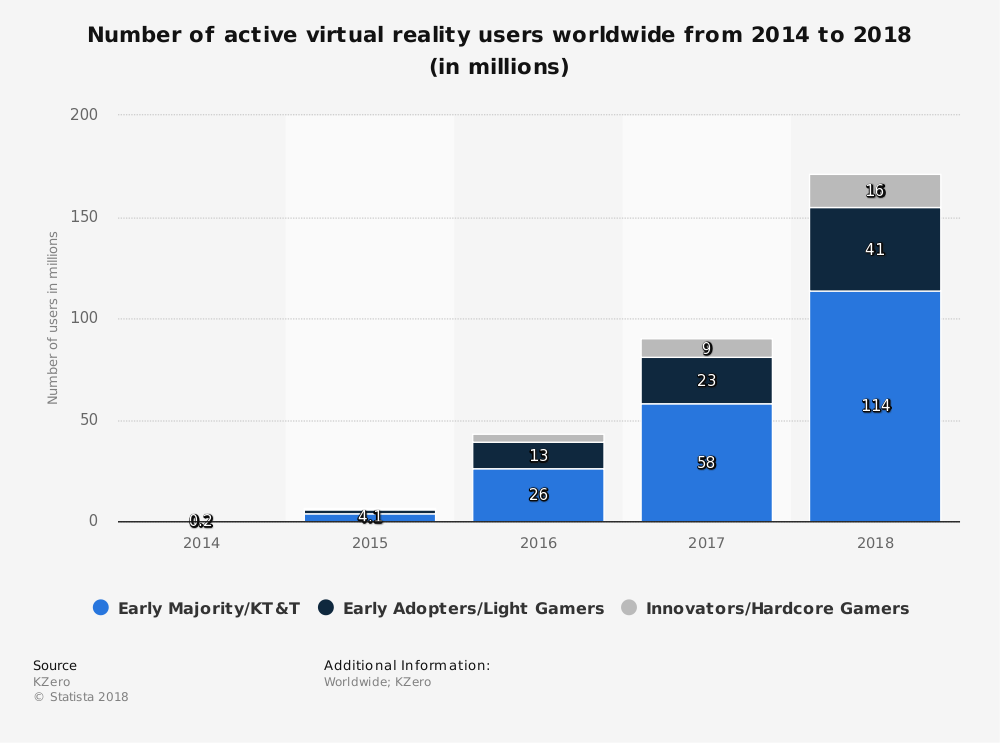CHANGING TECHNOLOGY
For some IVF centers, the change has already done them in. For others, it is the level playing field needed to thrive against massively funded competitors. No phenomenon presents a greater threat, nor a greater opportunity to today’s fertility centers than the technological revolution through which our society is living.
So far, we've deeply explored the four major implications of the following axiom: today's fertility practice is no longer a small, independent healthcare clinic, but an entrepreneurial venture. We talked about business structure, strategy and vision, and accelerated competition. These three tenets pale in comparison to our society’s rapidly changing technological and social behavior.
While all four of these elements have caused the tectonic shift from small healthcare office to entrepreneurial venture, none are more significant than this one, the drastic change of technology and society.
In this article, we mostly refer to consumer technology. Leave alone advances in medicine and laboratory technology, though their convergence may ultimately be indistinguishable. Rather than individually analyze various silos of the tech sector— such as social media, e-commerce, augmented reality, and artificial intelligence—we will examine how our relationships with our patients are changing, and more rapidly than we may realize, as a result of the speed of the changes happening in tech and society. These are just four implications of how advances in technology have changed our society, our patients, and consequently, our practices.
Information exchange has accelerated at an uneven pace, which has led to
Problems meeting needs and expectations which has contributed to the need to form
Connected communities of patients who have both equalized and imbalanced
Competitive advantages and disadvantages between large and small fertility practice groups.
And it’s only the beginning.
1). INformation EXCHAnge: Patients need more than providers can give
Travel back with me to the mid 1990’s. While today’s REI Fellows ran home from grade school to watch the latest episode of Saved By the Bell, the second generation of fertility sub-specialists left the universities to open their own fertility practices or start REI divisions at the hospitals. We’re referring to those who came after the pioneer generation of Howard Jones and Patrick Steptoe. Really, this class of baby-boomer REIs is the first generation of the fertility care provider whom we know today.
Now let’s imagine a couple from the same time period. They’ve been unable to conceive after two years of trying. How would they have found information on their
Diagnosis
They could go to the bookstore. There was likely a book or two that offered good introductory information on infertility and/or how to get pregnant. But how is one supposed to keep a best selling thriller like The Fastest Way to Get Pregnant Naturally by Christopher D. Williams, MD on the shelves for long? Maybe there was a seminar in their area. But how would they have found out about it?Support How would someone struggling with infertility have found professional or peer support? Could they just ask around town? RESOLVE was around, but it's not as though one could look them up in the yellow pages.
Treatment How did patients find their fertility provider? Would we have to hope that their OB/GYN or primary provider knew enough about emerging fertility care to direct them to the new sub-specialists in their area?
Think about the most powerful man in the world at that time, U.S. President, Bill Clinton. One of the most powerful supercomputers to which he had access was the Intel Paragon XP/140. Today, every one of your patients walks around with a supercomputer more powerful than that in their pocket. Because of that, our patients have access to more information than each of the world leaders from that time period as well. Information asymmetry is over, and it didn’t take long for these supercomputers to conquer our social habits.
The adoption of smart phones more than doubled from mid 2011 to late 2017 from 35% to 77%. 92% of adults ages 18-49 own a smartphone. You went to work one day and most of your patients did not have all of the world’s information at their fingertips. You came back to the same office six years later, and they did. The exchange of information has changed, but patients have outpaced their practices in their means to deliver and receive information, and that poses a problem in meeting patient expectations.
2). unable to meet patient expectation: not speaking the same language
“Not to use social media platforms is to be culturally incompetent. As a physician, we are supposed to give medical advice in a language the patient understands. Not doing so is considered to be medically inappropriate and can lead to adverse outcomes. If large segments of the population get the majority of their information digitally, isn’t it incumbent upon healthcare providers to provide information in an accessible, understandable way?”-Dr. Serena H. Chen, MD, REI
On a webinar that I conducted in August 2018, the most common challenge reported by fertility practice owners and managers was increasingly high patient expectations. Because patients have adopted the new methods of information exchange much more quickly, communication needs are frequently not met. This imbalance can negatively impact a fertility center’s relationship with its patients.
Patients are reaching out to practices through Facebook Messenger and Instagram at a quickly increasing rate. Patients spend most of their communication time on these channels, yet some practices don’t even have a contact form on their website. For younger patients, this is the equivalent of not having a telephone. On an average day, almost 40% of millenials interact with their smartphone more than anything or anyone else, including their significant other, according to 2016 research from Bank of America.
Practices are reporting challenges with meeting patient expectations, partly because technology has raised expectations of response time to a standard that staff cannot meet. Even if the expectations are unfair or unrealistic, fertility clinics are unable to reset those expectations if they are unable to effectively exchange information in balance.
Phone Calls
Today's patients reluctantly call you to schedule an appointment. Tomorrow's patients simply won’t. Every year, the idea of making a phone call to schedule a new patient appointment is all the more foreign. When they are consumers, patients are accustomed to instant transactions, as with transportation, hotels, entertainment, and food. A survey from the United Kingdom found that more than 25% of smartphone owners never use their phone to make a call, up from only 4% 3 years prior.Text Messaging
Pew also states that Americans made over 12 phone calls a day in 2011. In 2015, however, a report by Informate shows that Americans make or answer only 6 phone calls a day, while sending and receiving 32 texts and spending 14 minutes on Chat. By the time institutes like Pew can even report their conclusions, the changes have already accelerated.Chatbots
69% of consumers prefer interaction with chatbots for quick answers. Our prospective and current patients want (and expect) answers faster than we can respond to them. Think of the twenty most frequently asked questions that your front office staff has to answer over and over. They may even be answered as FAQs on your website. People expect these answers immediately, and the technology exists to meet that speed. See the example chabot flow below that can be used for your Facebook Messenger or website chat.
The future of chatbots for fertility centers
Video
45% of people watch more than an hour of Facebook or YouTube videos per week. How much video content does your fertility practice have? How much of it is on Facebook and YouTube?
The data suggest that clinics are unable to set and reset expectations with patients because the information exchange is imbalanced in such way that is insufficient to the patient. If patients and centers are not communicating in the same media, they are not speaking the same language. Consider this data point from the same Bank of America study: “the majority (67 percent) of Americans feel the appropriate response time to a text is under an hour, with 43 percent citing under 10 minutes and 10 percent thinking it should be instantly”. Contrast this with how long it takes your already work-loaded staff to respond to patients who are anxiously awaiting their test results. So they turn to each other.
3). COnnected communities of patients…and a chance to lead them
With the information exchange so out of balance, how are patients meant to process their information overload? Technologist Alex Kouts argues that reasoning by proxy, is the reliance on other people or organizations to offload one’s cognitive load, for forming a conclusion on complex subjects. Many patients rely on the experiences and opinions of their peers to help them process the very complex information they receive about infertility.
Part of the reason behind a massive social behavior change in our patient population is that people are now starting to talk about infertility. In the past, how could patients have connected with others to talk about their experience with infertility? Today, many people still struggle with infertility in silence, but hundreds of thousands of people worldwide are changing that.
#TTC stands for “trying to conceive” on social media. As of July 2018, the infertility hashtag had been used over 580,000 times and the #ttcsisters hashtag has been used almost 330,300 times on Instagram. There are thousands of infertility support groups and pages on Facebook, hundreds of infertility blogs, and dozens of podcasts about fertility.
The cat is out of the bag. Good!
If we want to encourage people who are struggling with infertility to pursue medical advice, then we want them to talk. People are now talking publicly about a very pressing problem which you are more qualified to address than virtually anyone in their area. By becoming the voice for people with infertility in your area, and the forum for which they can connect with information and support, we create a natural and honest referral system. To the extent that you can encourage this system by truly providing values to prospective patients, you will never want for new patients.
Smaller fertility practices have access to a word-of-mouth referral network that was never previously available to them. In Part 3 of this blog series, we discussed the major advantages that large, private equity backed practice groups have over independent fertility centers. Thankfully, large practice groups aren't so much better equipped to adapt to these changing habits as we are.
4). COMPETitive advantages and disadvantages: rigged game or level playing field?
Many patients don’t see a fertility specialist when they need to because they are scared and they have no idea what seeing a fertility doctor will be like. They don’t know who to trust, but they do trust their friends and relatives. In years past, most people would not have known that their cousin, co-worker, or college roommate struggled through many of the same problems which they currently face, much less that they saw a fertility specialist, whom, and how happy they were with him or her. Now, hundreds of people in a person's social network can see when they post a picture of their beautiful family to their fertility center's social media channels, and publicly thank their fertility doctor and care team.
Larger practice groups often spend more money on social media advertising, yes, that is true. Because of that they are taking patients from practices who are not active on social media. But those practices that constantly create content and engage their community are acquiring new patients by word-of-mouth faster than ever. In fact, some practices don't need to spend any money at all on social media advertising, because there organic reach is so high. If dozens to hundreds of patients refer your practice in a given month and help persuade strangers who are looking for social proof, you will never want for new patients again.
Large corporations can outspend your marketing budget. They will and they are. They can create referral programs for large OB/GYN groups. They can leverage better deals with insurance companies. But there is a kink in their armor: they have to keep up with patients' attention as much as you do. People struggling with infertility want to give you their attention. Many times, they think about nothing other than their problem and you have at least part of the solution. If you make the effort to build trust with them and help them where they spend the most attention, you can reach them in such a way that large competitors cannot.
The tech revolution and reproductive health
ONLY the beginning
We are only at the very beginning of this technological revolution, which is greater than that of Johann Guttenberg and the printing press. Marketing for fertility clinics is only one facet of how consumer technology has changed reproductive health. Companies and products are invented every day that can change our field forever. Consider these breakthroughs and their potential ramifications in our field.
Think of AI in the IVF lab
Artificial Intelligence
Error rates for image labeling have fallen from 28.5% to below 2.5% since 2010. On this specific test, AI is now more accurate than human performance. Imagine artificial intelligence being used to
Score embyro quality
Predict success of recommended prognosis
Real time diagnosis
Virtual and Augmented Reality
Statista estimates that there are 171 million active users of augmented reality in 2018. A 2016 poll of consumers in the United States by ClickZ found that more than a third (37%) have now used either their own or someone else’s VR headset. In the not distant future, VR and AR may be used to
Provide initial consults
Tour the practice and IVF lab
Take CME lectures and courses
Blockchain
Blockchain technology scopes far beyond the function of currency. Blockchain is the digitized, decentralized, public ledger of transactions of virtually any kind. The number of Blockchain wallets has been growing since the creation of the Bitcoin virtual currency in 2009, reaching over 25 million Blockchain wallet users at the end of June 2018. Accenture estimates that 30% of operating costs could be eliminated using Blockchain. Blockchain development is still in its very early life, but it could be used in reproductive health to
Replace electronic medical records
Finance treatment
Integrate systems such as billing, records, results, and treatment protocol
change is here
Whether we like it or not, the REI practice of 2019 can no longer be designed as a small medical clinic. Whether its motives are profit driven or in service to the betterment of humanity, or anywhere along that spectrum, it is an entrepreneurial venture. We’ve examined how the world has changed dynamically in the last two decades and will change even more in the next two. To succeed, fertility centers need to be structured as an entity that is led by a visionary, with a strategy and vision that account for powerful competitors and the ability to adapt as quickly to social and technological changes as quickly as our patients do.
The variables for which we need to account are infinite if we try to keep pace with our society’s technological revolution as a whole. If we manage to keep pace with our patients, however, we have access to a breadth of opportunity the likes of which the world has never seen.






